In the open land, the oleander is a large ornamental bush, decorated with large inflorescences (can be of different colors). He feels great in a warm climate. In areas where hot weather reigns year-round, oleander shrubs in the garden are often found.
At home, you can also succeed and grow chic bushes of flowers, but the size of the oleander and its thermophilicity entail some nuances in terms of care and cultivation. Lush flowering, as in the photo, can be achieved only with proper cultivation of the bush.
Content
How to grow and care for oleander
In nature, the shrub is well lit and ventilated, therefore it should create similar conditions in closed ground.
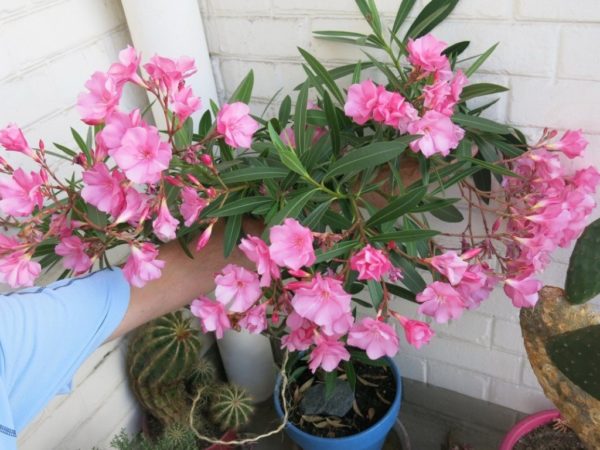
When the oleander spends more time in the shade, then:
- its leaves fade;
- young leaves become smaller, flowers become rarer, and will no longer resemble a round ball;
- the distance between the leaves will increase;
- young shoots look pale and helpless.
If the oleander is kept in the shade for a very long time, it may cease to bloom at all. Therefore, in the summer it is recommended to relocate under the open sky. When the temperature keeps around + 20 ... 25 ° C, the flower easily acclimates to the fresh air and begins to develop rapidly.
In this case, the shrub should not be planted in the ground, otherwise a large number of new roots will form, which you can simply not cope with in the fall. But if the garden has an open pond, a pot of oleander is best prikupat just next to the water.
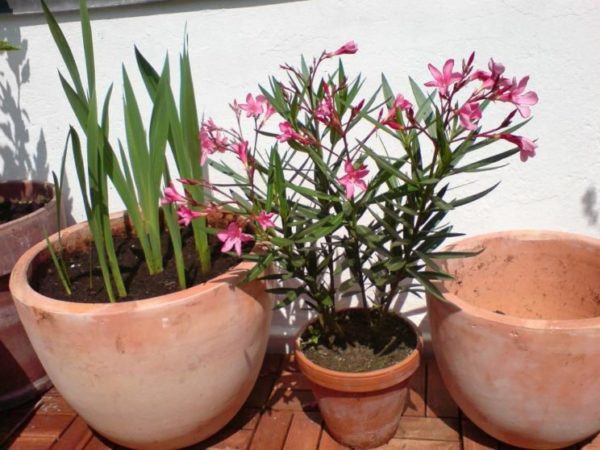 Moisture helps the leaves resist the bright sun in the heat. When there is no pond in the garden, a bucket of water placed next to the pot will help. Indoors, it is recommended to place the container on a pallet with wet expanded clay or moss.
Moisture helps the leaves resist the bright sun in the heat. When there is no pond in the garden, a bucket of water placed next to the pot will help. Indoors, it is recommended to place the container on a pallet with wet expanded clay or moss.
When an oleander is grown in a house or apartment, it must be sprayed with warm water. Thanks to proper care and growing, his crown will be clean, and besides, the humidity near the bush will be sufficient for growth at home. Flowering, as in the photo, can be ensured only by correctly following all the rules of cultivation.
How to post
For permanent residence, the oleander is best suited to the south side. A little less acceptable is the room on the east side of the apartment or house. You can not put the shrub in rooms whose windows face north or west, since there will not be enough light for growing it.
During daylight hours, leaves and flowers should be lit. Oleander easily tolerates the direct rays of the sun and is not afraid even of the scorching heat. Therefore, on hot days you can bring a flower to the balcony or a glazed veranda. But the room must be closed to avoid rainfall and drafts.
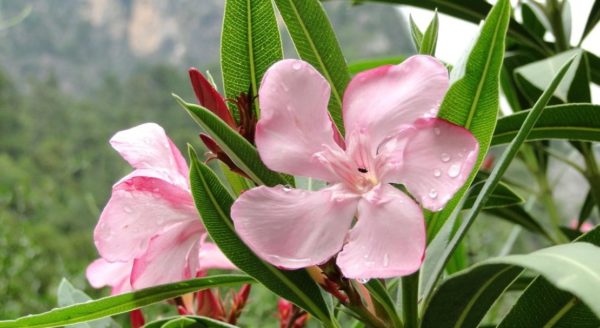 When the sunny day is waning, and this happens in late autumn and lasts until spring, the flowers and leaves of the oleander need additional lighting.
When the sunny day is waning, and this happens in late autumn and lasts until spring, the flowers and leaves of the oleander need additional lighting.
Young shoots in small pots can be placed on the windowsill, a special stand or on a shelf near the windows. Adult flowers require large pots that are placed on the floor.They also need to be settled close to sources of natural or artificial light.
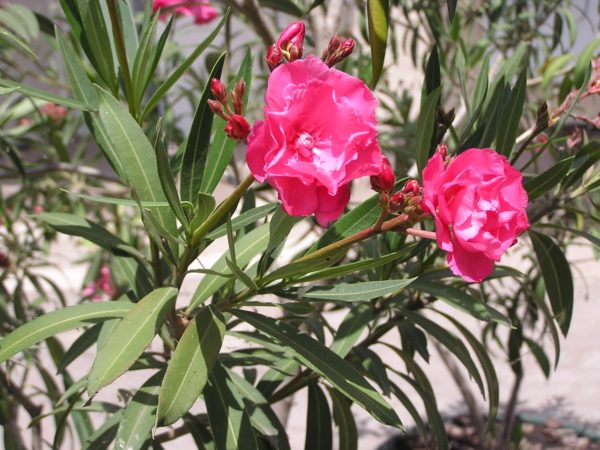
Those who have their own summer cottage or garden are very lucky, because for the whole summer you can take a bush there. When the temperature outside is around + 22 ... 26 ˚C, it grows beautifully and gives excellent inflorescences. In this case, you do not need to get it out of the pot and plant it in open ground, it is better to place it near the water.
Temperature for oleander
Fresh air and warmth are the best friends for the oleander. In summer, he is comfortable at a temperature of + 22 ... 25 ˚C, and in winter, the main thing is that the temperature does not fall below +5 ˚C. A constantly maintained temperature regime, for example, +20 ˚C, is optimal.
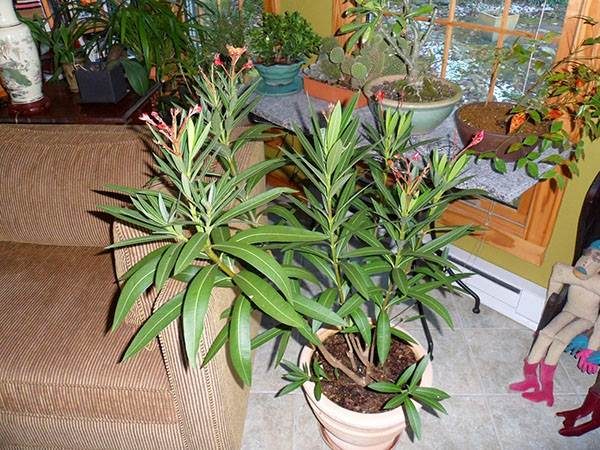 Shrub negatively refers to the rapid change in temperature. If it is waiting for colder time, then you need to cook gradually, reducing the thermometer by 1-2 divisions per day. The shrub will be able to tolerate a short stay in the cold, but he will not survive the winter in the garden.
Shrub negatively refers to the rapid change in temperature. If it is waiting for colder time, then you need to cook gradually, reducing the thermometer by 1-2 divisions per day. The shrub will be able to tolerate a short stay in the cold, but he will not survive the winter in the garden.
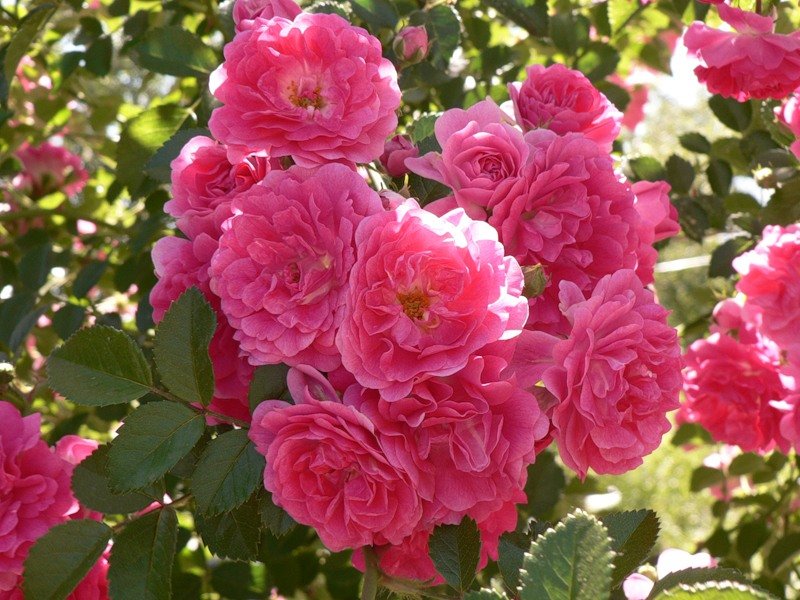 You may be interested in:
You may be interested in:How to water
In spring and summer, and especially in hot weather, the plant needs abundant watering. At this time, the oleander, if it is provided with proper care and cultivation, is actively developing, and its stems and leaves evaporate moisture. To maintain the proper level of humidification at home, it is recommended to leave water in the pan.
Watering method is better to choose the bottom. At the same time, it is necessary to carefully ensure that the soil does not dry out on top, especially on hot days, then the flowering of the bush will be as in the photo below.
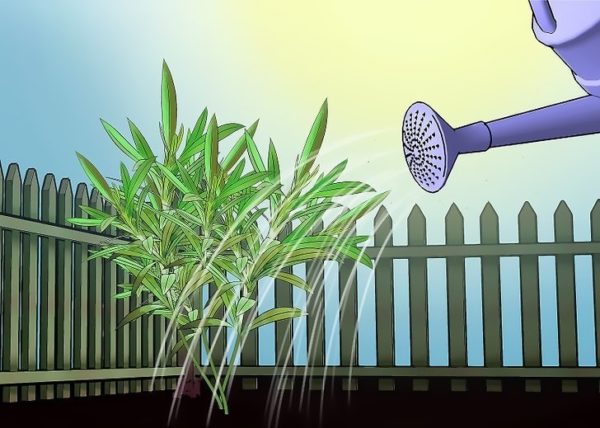
On the contrary, in cold weather, watering should be reduced, then the shrub will go into a state of rest and gain strength in order to begin to bloom profusely in spring. During this period, overmoistening of the soil should be avoided, as this can lead to decay of the roots and death of the plant.
Bathing and spraying
Since the oleander loves moisture, it should periodically arrange water procedures. When it’s especially hot, you can transfer the plant to a bath or a large basin with cool water and pour it from the shower. In this case, the earth must be buried with a film, otherwise it will be washed, the root system will be exposed.
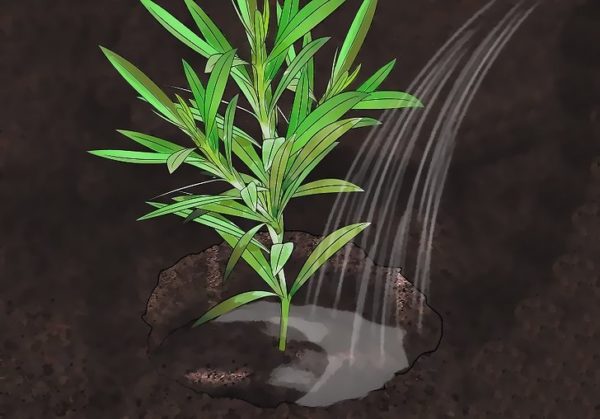
Another measure to maintain moisture is to spray cool water from the spray bottle. It is especially important to do this when the radiators are working at full strength and dry the air.
Is feeding necessary
When the oleander has just been planted or transplanted, it takes nutrients from fresh soil and does not need additional nutrition for the next one and a half to two months. After this time, especially if the inflorescences begin to swell, it is recommended to feed the plant regularly, at least twice a week. You need to use special mineral fertilizers for plentifully blooming indoor flowers.
Reservation
In order for the bush to take on the shape of a tree with a strong crown, you need to trim the extra shoots at the roots. Otherwise, it will take the form of wild.
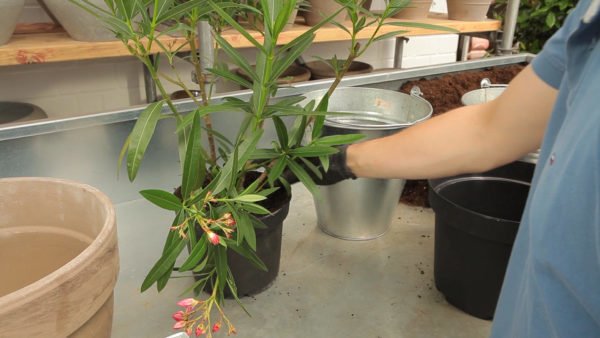 Long stems also need to be shortened, since when stretched up to two meters in length, the lower leaves weaken and fall. To give the desired shape to the crown of the bush should be in the fall, when the abundant flowering is already over.
Long stems also need to be shortened, since when stretched up to two meters in length, the lower leaves weaken and fall. To give the desired shape to the crown of the bush should be in the fall, when the abundant flowering is already over.
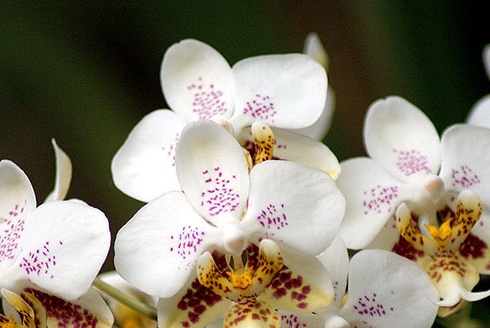 You may be interested in:
You may be interested in:Breeding methods
There are several ways to breed oleander at home.
Propagation by cuttings
When the bush is cut to form a crown, in any case, extra shoots are found, those that are knocked out of the desired crown or grow at the roots.

After they are pruned, these stems can be used for further propagation of the shrub. Suitable young cuttings should have several leaflets and a growth point, their optimal length of about 15 cm.
Planted shoots will quickly take root and begin to grow rapidly. A year later, next fall, you can begin to form the crown of the future beautiful shrub.
Propagation by air layering
With this method, you will need to make more efforts, however, as a result, at home you can get a plentifully flowering young oleander shoot. The procedure of reproduction (in order for the bush to bloom, as in the photo), further care and cultivation includes several steps:- First you need to choose a young escape.
- At a distance of 10-15 cm from the edge, circular cuts must be made on the cortex.
- Wet sand is put in a bag and a bare place is wrapped. The sand should completely cover the cut and adjoin tightly to maintain humidity.
For this purpose, you can use not sand, but peat moss - sphagnum.
The first roots will appear in a month. When the root system becomes stronger, the future oleander is cut from the mother stem and planted in a separate pot. It is recommended to sprinkle the place of cut with ash or crushed coal.
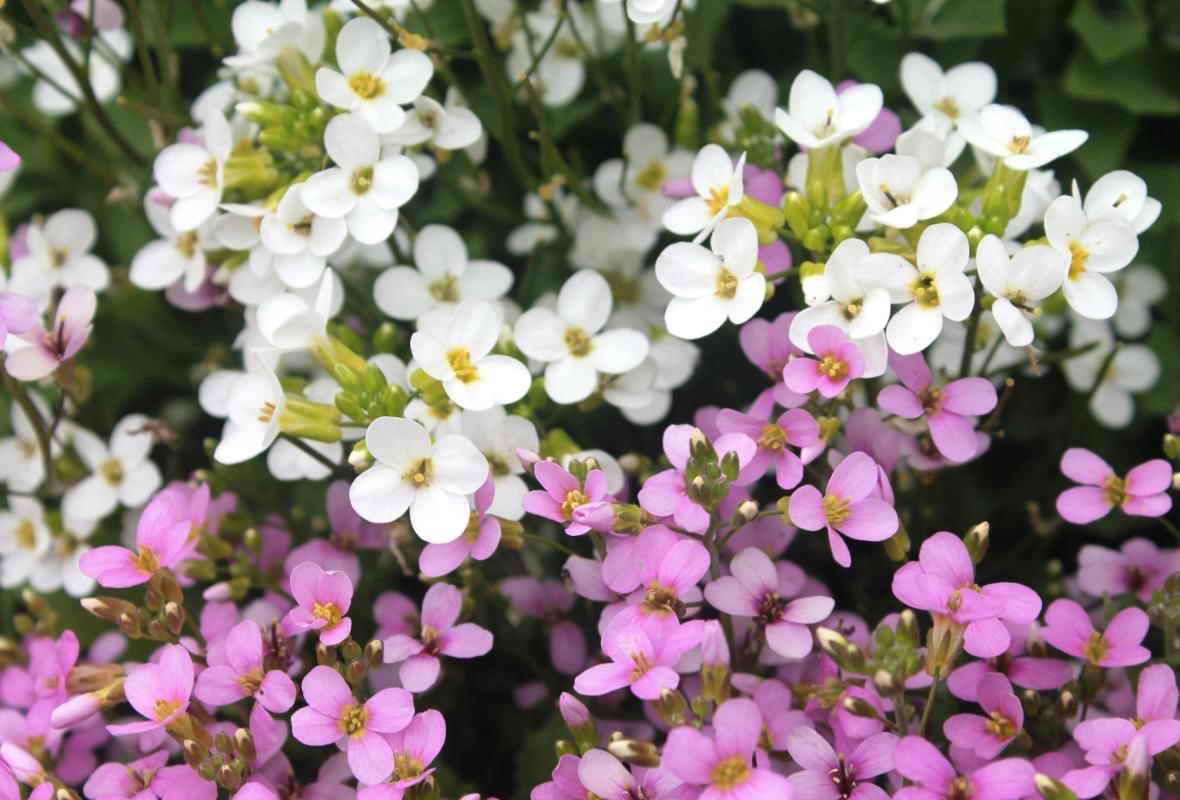 You may be interested in:
You may be interested in:What is the oleander sick
The oleander has few diseases, nevertheless, they have:
- When the tips of the leaves become thinner and dry, this means the plant lacks moisture. In order not to aggravate the situation, it is necessary to establish watering and carefully monitor the soil moisture. In hot weather, add water to the pan. To evaporate liquid near the plant, you need to arrange containers filled with water. And the situation with dry air in the room can be eliminated with the help of a sprayer.
- Yellowing leaves indicate either the wrong choice of mixture for feeding, or about excessive watering of the plant. To solve the problem, it is advised to renew the earth in the pot and monitor its moisture.
- The appearance of black dots on the leaves indicates a fungal disease. Because of it, the process of photosynthesis slows down, and the plant loses strength.
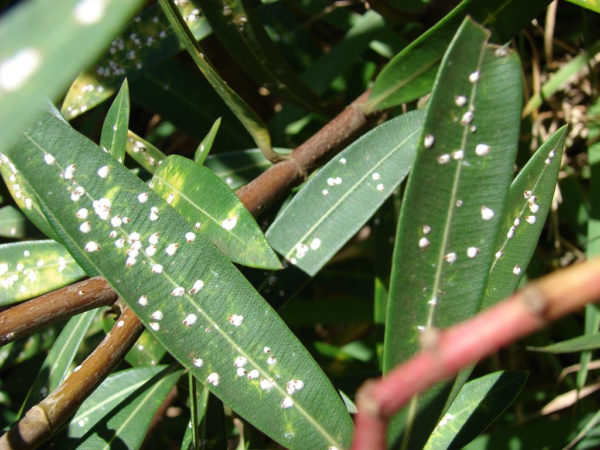
- When the shrub does not have enough light, it begins to throw off the lower leaves. In summer, you can put the flower pot closer to the natural color springs, ideally on the balcony or porch. In winter, you can extend the daylight hours for oleander using fluorescent lights.
- Drafts or hypothermia can lead to massive discharge of leaves. The pot with the plant should be urgently rearranged to a warmer place. When the room is ventilated, the oleander is better to evict from it for a while. If the bush is on the balcony, then you need to monitor the temperature, and in cold nights bring a flower into the house. Another reason for the "baldness" of the bush may be a lack of light. Photosynthesis is not produced in the dark, the plant does not develop.
Beautiful caps of inflorescences at any time of the year create a light summer atmosphere in the house. In autumn and spring, contemplation of greenery and flowers can help in the fight against spleen. If you understand the vagaries of this shrub and prevent their consequences, you can enjoy a gorgeous, lush-blooming flower at home for a long time. Caring for an oleander is not difficult.Growing a plant is simple, if done correctly, the bush will bloom, as in the photo.




 Sow in the ground, without seedlings: 10 beautiful and unpretentious flowers
Sow in the ground, without seedlings: 10 beautiful and unpretentious flowers Platicodon planting and outdoor care
Platicodon planting and outdoor care Hosta - planting and care in the open ground in the Urals
Hosta - planting and care in the open ground in the Urals Oleander - care and growing at home
Oleander - care and growing at home